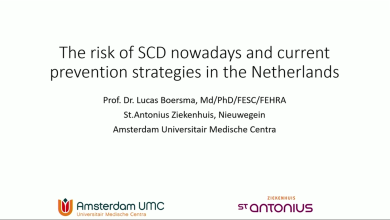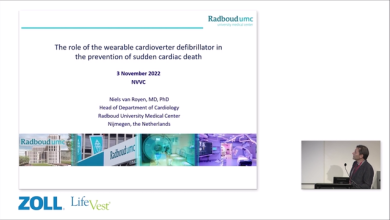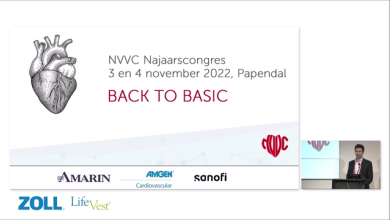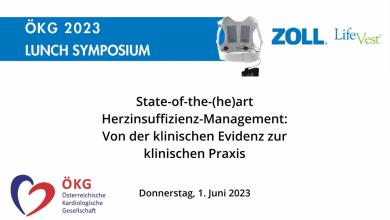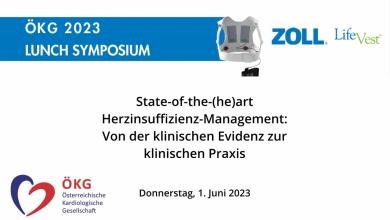In This Section:
Sudden Cardiac Death
Proven Therapy for Patients at Early Risk of Sudden Cardiac Death
The risk of sudden cardiac death (SCD) or serious cardiac arrhythmias in patients with heart failure is particularly high in the initial period after an acute cardiac event.1,2 Also the clinical condition of patients often changes during this time.3 Therefore the medication is optimally adjusted in accordance with guideline recommendations before a decision is made on the necessity of further long-term therapy, such as the implantation of an implantable cardioverter defibrillator (ICD).4
Left-ventricular ejection fraction (LVEF) is still the most reliable predictor of this risk. According to the guidelines of the European Society of Cardiology (ESC) and of the American Heart Association (AHA)/American College of Cardiology (ACC)/Heart Rhythm Society (HRS), patients with an LVEF ≤ 35% after an acute cardiac event should be considered for a wearable cardioverter defibrillator (WCD; LifeVest® ZOLL CMS) during the three-month drug therapy optimization phase.4, 5, 6 This approach is supported by extensive evidence, including data from more than 20,000 patients from retrospective and prospective registries and a large randomized controlled trial, demonstrating the clinical effectiveness of the WCD in terminating ventricular tachyarrhythmias.1, 7-11 The median wearing time in the most recent European registries were above 23 hours daily.9, 12
The LifeVest wearable cardioverter defibrillator is a treatment option for patients at risk of sudden cardiac death that can offer advanced protection and monitoring during the early period after a cardiac event while medical therapy is being optimized and permanent risk is established. Unlike an ICD, LifeVest is worn outside the body rather than implanted in the chest. LifeVest is designed to continuously monitor a patient’s heart, detect certain life-threatening rapid heart rhythms, and automatically deliver a treatment shock to restore normal heart rhythm.
Prof Christian Perings

Section Advisor
Prof Christian Perings
The Sudden Cardiac Death section is supported by ZOLL

Video Series
Marco Bergonti, Bruce Wilkoff, Carlo Pappone, et al
Video
Recent Videos
Video
Video
Video
Clinical publications
Roston TM, Wei J, Guo W, et al. JAMA Cardiol 2022;7:84–92.
Biddinger KJ, Jurgens SJ, Maamari D, et al. JAMA Cardiol 2022;7:715–22.
Finocchiaro G, Westaby J, Behr ER, et al. JAMA Cardiol 2022;7:358–9.
Young WJ, Lahrouchi N, Isaacs A, et al. Nat Commun 2022;13:5144.
Lee DZJ, Montazeri M, Bataiosu R, et al. JACC Cardiovasc Imaging 2022;15:1696–711.
Razavi AC, Uddin SMI, Dardari ZA, et al. JACC Cardiovasc Imaging 2022;15:1259–70.
Ghonim S, Gatzoulis MA, Ernst S, et al. JACC Cardiovasc Imaging 2022;15:257–68.
Schrage B, Lund LH, Benson L, et al. Eur J Heart Fail 2022;24:1212–22.
Boas R, Sappler N, von Stülpnagel L, et al. Circulation 2022;145:754–64.
Steinberg C, Dognin N, Sodhi A, et al. Circulation 2022;145:742–53.
Friedman DJ, Qin L, Parzynski C, et al. J Am Coll Cardiol 2022;79:1050–9.
Norrish G, Cleary A, Field E, et al. J Am Coll Cardiol 2022;79:1986–97.
Sandhu RK, Dron JS, Liu Y, et al. J Am Coll Cardiol 2022;80:873–83.
Leyva F, Zegard A, Okafor O, et al. J Am Coll Cardiol 2022;79:665–78.
Empana JP, Lerner I, Valentin E, et al. J Am Coll Cardiol 2022;79:1818–27.
Yafasova A, Butt JH, Elming MB, et al. Circulation 2022;145:427–36.
Protonotarios A, Bariani R, Cappelletto C, et al. Eur Heart J 2022;43:3053–67.
Hadwiger M, Dagres N, Haug J, et al. Eur Heart J 2022;43:2591–9.
Jordà P, Bosman LP, Gasperetti A, et al. Eur Heart J 2022;43:3041–52.
Lambiase PD, Theuns DA, Murgatroyd F, et al. Eur Heart J 2022;43:2037–50.
Ladouceur M, Van De Bruaene A, Kauling R, et al. Eur Heart J 2022;43:2685–94.
Cadrin-Tourigny J, Bosman LP, Nozza A, et al. Eur Heart J 2022;43:e1–9.
Li L, Scott CA, Rothwell PM. JAMA 2022;328:563–74.
Guidelines
Zegkos T, Tziomalos G, Parcharidou D, et al. Hellenic J Cardiol 2022;63:15–21.
Gan L, Lyu X, Yang X, et al. Front Med (Lausanne) 2022;9:877237.
Warming PE, Ågesen FN, Lynge TH, et al. Am Heart J 2022;245:117–25.
Dunning J, Archbold A, de Bono JP, et al. Heart 2022;108:e1–18.
Sabbag A, Essayagh B, Barrera JDR, et al. Europace 2022; epub ahead of press.
Chen LY, Ribeiro ALP, Platonov PG, et al. Circ Arrhythm Electrophysiol 2022;15:e010435.
Mehra R, Chung MK, Olshansky B, et al. Circulation 2022;146:e119–36.
Dainty KN, Colquitt B, Bhanji F, et al. Circulation 2022;145:e852–67.
Radcliffe Content
Interventional Cardiology 2023;18:e29.
Arrhythmia & Electrophysiology Review 2023;12:e27
Arrhythmia & Electrophysiology Review 2023;12;e17.
Arrhythmia & Electrophysiology Review 2023;12:e10.
Interventional Cardiology 2023;18:e11.
Review Articles
Abdelhamid M, Rosano G, Metra M, et al. Eur J Heart Fail 2022;24:1460–6.
Lukas Laws J, Lancaster MC, Shoemaker MB, et al. Circ Res 2022;130:1698–722.
Maron BJ, Desai MY, Nishimura RA, et al. J Am Coll Cardiol 2022;79:390–414.
Odening KE, van der Linde HJ, Ackerman MJ, et al. Eur Heart J 2022;43:3018–28.
Schwartz PJ, Ackerman MJ. Eur Heart J 2022;43:2096–102.
Marijon E, Garcia R, Narayanan K, et al. Eur Heart J 2022;43:1457–64.
Khairy P, Silka MJ, Moore JP, et al. Eur Heart J 2022;43:2103–15.
Trayanova NA, Topol EJ. Lancet 2022;399:1933.
Sources:
- Olgin JE, et al. N Engl J Med 2018;379:1205–15.
- Solomon SD, et al. N Engl J Med 2005;352:2581–8.
- Kutyifa V, et al. Circulation 2015;132:1613–9.
- Ponikowski P, et al. Eur Heart J 2016;37:2129–200.
- Priori SG, et al. European Heart Journal 2015;36:2793–867.
- Al-Khatib SM, et al. Circulation 2018;138:e272–391.
- Epstein AE, et al. JACC 2013;62:2000–7.
- Kutyifa V, et al. Circulation 2015;132:1613–9.
- Wäßnig NK, et al. Circulation 2016;134:635–43.
- Nguyen E, et al. J Innov Card Rhythm Manag 2018;9:3151–62.
- Olgin JE, et al. J Cardiovasc Electrophysiol 2020;31:1009–18.
- Garcia R, et al. EP Europace 2021;23:73–81.














